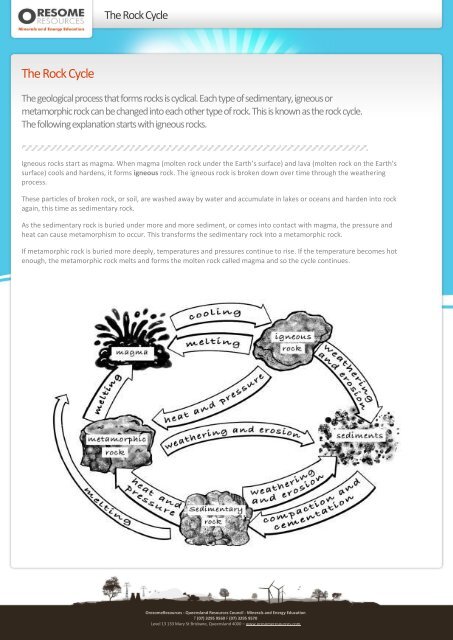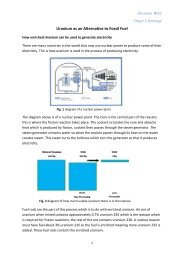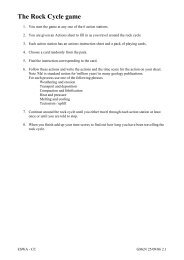The Rock Cycle
The Rock Cycle
The Rock Cycle
Create successful ePaper yourself
Turn your PDF publications into a flip-book with our unique Google optimized e-Paper software.
<strong>The</strong> <strong>Rock</strong> <strong>Cycle</strong><br />
<strong>The</strong> <strong>Rock</strong> <strong>Cycle</strong><br />
<strong>The</strong> geological process that forms rocks is cyclical. Each type of sedimentary, igneous or<br />
metamorphic rock can be changed into each other type of rock. This is known as the rock cycle.<br />
<strong>The</strong> following explanation starts with igneous rocks.<br />
Igneous rocks start as magma. When magma (molten rock under the Earth’s surface) and lava (molten rock on the Earth’s<br />
surface) cools and hardens, it forms igneous rock. <strong>The</strong> igneous rock is broken down over time through the weathering<br />
process.<br />
<strong>The</strong>se particles of broken rock, or soil, are washed away by water and accumulate in lakes or oceans and harden into rock<br />
again, this time as sedimentary rock.<br />
As the sedimentary rock is buried under more and more sediment, or comes into contact with magma, the pressure and<br />
heat can cause metamorphism to occur. This transforms the sedimentary rock into a metamorphic rock.<br />
If metamorphic rock is buried more deeply, temperatures and pressures continue to rise. If the temperature becomes hot<br />
enough, the metamorphic rock melts and forms the molten rock called magma and so the cycle continues.<br />
OresomeResources - Queensland Resources Council - Minerals and Energy Education<br />
T (07) 3295 9560 F (07) 3295 9570<br />
Level 13 133 Mary St Brisbane, Queensland 4000 – www.oresomeresources.com
Activity: Creating a <strong>Rock</strong> <strong>Cycle</strong> Flowchart<br />
Purpose<br />
To identify and describe some interactions within a system — the rock cycle.<br />
Procedure<br />
1. Read ‘<strong>The</strong> rock cycle’.<br />
2. Using as many of the rock cycle cards as you can, make a flowchart to explain how the rock cycle works.<br />
3. Cut out the rock cycle cards and arrange them on an A3 sheet linking them together with the words and arrows<br />
cards.<br />
4. Do not glue down the cards until you are sure of where you want to put them all.<br />
OresomeResources - Queensland Resources Council - Minerals and Energy Education<br />
T (07) 3295 9560 F (07) 3295 9570<br />
Level 13 133 Mary St Brisbane, Queensland 4000 – www.oresomeresources.com






